Acne on the face of women is not only a cosmetic problem, but also a sign of health problems, sometimes very serious. Therefore, treatment of facial acne in women should be carried out comprehensively using local and general remedies, as well as following the rules of facial skin care.
Causes of acne
The causes of acne on the face in women are a combination of several factors. First of all, there is excess production of sebum, so acne on women’s faces often occurs with oily dermis. The next link in the pathogenesis is blockage of the ducts of the sebaceous glands with an excessive amount of secretion and the formation of so-called blackheads, most often on the lower part of the face. When an infection occurs, including normal skin microorganisms, inflammation occurs and acne appears on the face of women.
Factors that trigger the pathological process may be:
- Hormonal imbalance (puberty, pregnancy, menopause, endocrine diseases);
- Immune system disorders (including diabetes mellitus);
- Excess weight and poor nutrition also take their place among the causes of facial acne in women;
- The influence of toxic substances - occupational hazards, unfavorable environmental conditions;
- Improper skin care;
- Other causes of acne on the face in women.
Most often, there is either a combination of several factors or serious health problems, where acne on the face is the lesser of the evils. In addition, rashes associated with infectious or allergic diseases are often mistaken for acne.
In dermatology, there are several types of rashes on the face and neck, each of which has its own causes and treatment features. The most harmless are open comedones (blackheads), which appear when the sebaceous glands are blocked without inflammation. Closed comedones or whiteheads are a kind of subcutaneous pimples. The blockage is located deep under the skin, at the base of the excretory duct, and large fatty deposits appear on the surface - most often this happens with hormonal imbalances. Both of these types of acne are non-inflammatory manifestations of acne in adult women and teenage girls.
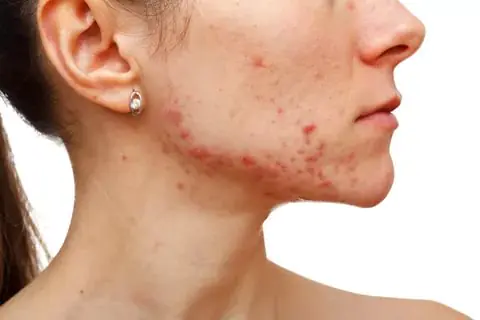
Inflamed rashes along the contour of the face are formed if an infection gets into the blocked duct. This is not difficult to do, so acne on the face of an adult woman quickly passes into the inflammatory stage.
A papule is a small nodule, slightly raised above the surface of the skin, bright red in color, painful with strong pressure, characteristic of any age - from teenagers to women over 45. A more complex formation is a pustule, abscess. It differs from a papule in its larger size and more pronounced pain, although the causes of red pimples are very similar. If you crush the papule, a small amount of pus is released.
In addition, a clinical classification has been adopted for the causes of facial acne in women of reproductive age, adolescents and girls, which examines in detail more than 20 types of acne.
Before wondering how to treat acne on the face of women, it is important to learn to distinguish them from rashes caused by serious diseases of connective tissue, immunity, and inflammatory skin pathologies. One of the main signs is that the dermis around acne is not involved in the inflammatory process, it remains healthy and has a normal appearance.
Nutrition and lifestyle for acne
Having understood why acne occurs, it becomes obvious that the problem must be solved comprehensively. Many representatives of the fairer sex, especially adults, think that they know how to eat properly, and their diet has absolutely nothing to do with dermatological problems. This is not so - an excess of fatty foods and a lack of vitamins leads to disruption of the sebaceous glands. In addition, gastrointestinal diseases impair the absorption of nutrients.
The first thing you need to do to treat facial acne in adult women is to review your diet. And not only for those who eat irrationally, but also for athletes on fat-free diets.
Vitamins necessary for the skin (A and E) are fat-soluble, and the body can only absorb them together with fats. Vegetable oils are best suited for this. But animal fats should really be excluded from the diet if possible.
If the patient suffers from any diseases of the stomach or intestines, she needs to follow a particularly strict diet.
Before treating acne on the face of a woman with digestive disorders, you need to contact a nutritionist who will help you create a therapeutic diet with a selection of products.
Facial skin care
Without a doubt, facial skin care is a key link in eliminating acne, especially for mature women over 40. A cosmetologist will help you choose the right care system, but you can even independently assess the type of your dermis and understand what it needs.
If acne appears on the face, the cause in women is often considered to be oily skin. But the trouble is that the dermis can become oily, paradoxically, from lack of nutrition and hydration. The pathogenesis chain here is quite simple - there is not enough hydration - the skin produces more sebum - acne appears. Therefore, it is necessary to regularly use moisturizing and nourishing creams to normalize sebum production.
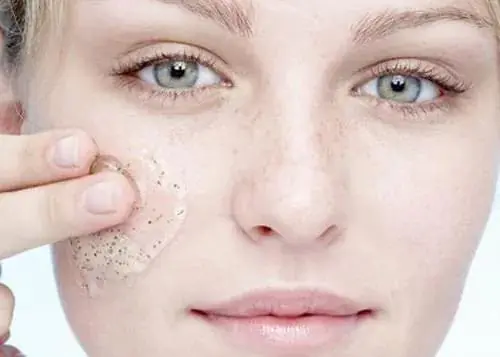
To get rid of sebaceous plugs, which are the main reason why acne occurs, you should use scrubs for deep cleansing of the skin, gels for washing against blackheads and other products that eliminate blockage of the ducts of the sebaceous glands.
Since the main cause of purulent acne is infection, care should be taken to eliminate it. In this case, local antiseptics that are gentle on the skin are preferred - miramistin, chlorhegsidine. You should refrain from alcohol solutions and hydrogen peroxide - they dry the skin, causing increased sebum production.
Local antiseptics and scrubs should be applied to clean and dry skin, and gels should be used while washing. Antibacterial soap does not cope well with acne, so it makes no sense to consider it as a remedy.
Drug treatment
If acne stubbornly does not go away with a review of your diet and lifestyle, and proper facial care, it is likely that it means a serious disease of the endocrine, digestive or immune system. In this case, you need to stop self-medication and consult a doctor to prescribe treatment for the underlying disease.
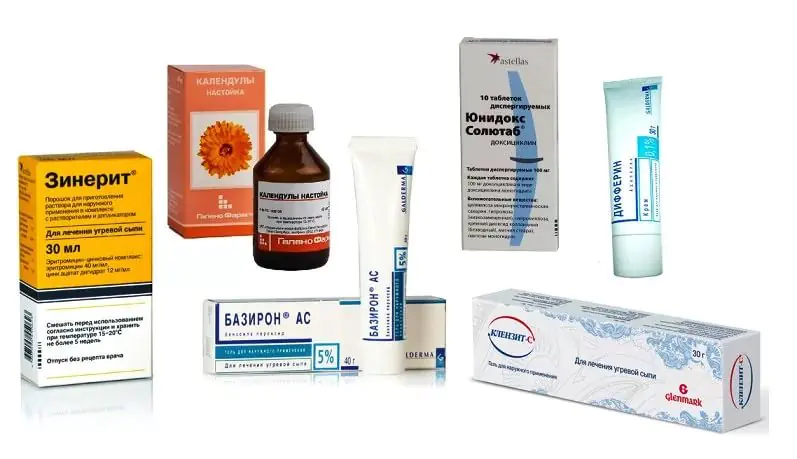
To combat acne itself, various medications can be prescribed. First of all, these are vitamins A and E in capsules or the drug Aevit. Fat-soluble vitamins maintain skin health, normalize sebum production, and ensure normal hydration and nutrition of the facial skin. In addition, immunomodulatory drugs, anti-inflammatory drugs and antibiotics may be prescribed.
People over 30 should pay special attention to the condition of their dermis in order to prevent problems with it in the future. This will help with preventive courses of vitamins and immunomodulators (as prescribed by a doctor!), procedures to maintain youthful and fresh skin, and a healthy lifestyle. All this will help slow down the withering.
Conclusion
The causes of acne on the face in women can be varied, and before starting treatment, the provoking factor should be determined. They need to be dealt with comprehensively - eliminating not only the skin symptoms themselves, but also the possible pathologies that lead to their occurrence. Sometimes you have to radically change your lifestyle for the sake of beautiful skin - unhealthy diet, stress and bad habits are detrimental to beauty.
To effectively combat acne, it is not enough to know a good dermatologist and acquire an arsenal of special cosmetics. Ideally, it is better to prevent a problem, and to do this you need to be aware of its causes.
- Causes of acne
- Acne map on face
- Determining the severity of the disease
- Preventive measures to combat acne
- Tools Overview
Causes of acne
Not so long ago, recurrent acne on the face received the status of a disease called “acne”, or “acne disease”. The attitude towards them has also become more serious, not just as a local cosmetic defect.
A pimple is an inflammatory element. The process of inflammation is associated with the sebaceous gland. When the outflow of sebum is disrupted for some reason, the ducts of the sebaceous glands become clogged, and acne propionbacteria begin to multiply in them.
To date, several factors have been studied that provoke disruption of the outflow of sebum and inflammation of the sebaceous glands.
Floury, sweet and fatty foods are often the causes of acne © iStock
Poor nutrition
Flour, sweets, and fatty foods are blamed for the appearance of acne - however, these three can be blamed for almost any health problem. Indeed, if you remove these foods from your diet, your skin will become noticeably clearer.
Prevention of rashes includes a healthy, balanced diet and the presence of essential vitamins in the diet. In particular, vitamins A, C, group B. To compensate for the deficiency of useful substances, you can take them in tablets or capsules.
Illiterate care
Oily skin is especially prone to increased activity of the sebaceous glands. That is why she needs products designed specifically for her. Cosmetics for other skin types will not be suitable - they are not able to remove excess fat, if we are talking about cleansing and moisturizing properly (to normalize sebum production).
The ducts of the sebaceous glands become clogged with excess sebum, which mixes with dead epidermal cells, particles of makeup, and everyday pollution. In this regard, when caring for oily skin, special emphasis should be placed on cleansing.
Obviously, touching your face with dirty hands or using unwashed brushes for cosmetics means provoking acne.
Hormonal imbalance
To combat acne, products based on zinc, salicylic acid, and clay are produced. © iStock
And if estrogens (female sex hormones) suppress the production of sebum, then androgens (male hormones), on the contrary, stimulate it. In addition, the point is not so much in the excess of androgens, but in the sensitivity of the sebaceous gland receptors to them. Therefore, with the same hormone levels, one person will have acne and another will not.
Acne in a woman after 20-30 years is a reason to visit a gynecologist and endocrinologist.
Diseases
These are mainly problems with the gastrointestinal tract. If there are problems with digestion (including as a result of poor nutrition), the balance of microflora is disrupted. This also affects the condition of the skin.
Digestive disorders lead to an excess of toxins in the gastrointestinal tract, from where they enter the bloodstream and can negatively affect the condition of the skin, contributing to the occurrence of inflammation.
Emotional condition
For a person with problem skin, stress is a powerful risk factor. The pimple pops up at the most crucial moment, because this moment is associated with emotions and excitement.
“It is known that the stress hormone cortisol provokes increased production of sebum and, as a result, clogged pores,” explains Vichy brand expert Elena Eliseeva.
For the same reason, the connection between deteriorating skin quality and lack of sleep becomes clear. Lack of sleep is also stressful for the body.
Stress and lack of sleep often trigger rashes. Avoid both. © iStock
Climatic factor
Subcutaneous mite
Demodex (subcutaneous mite) is a rather controversial cause of acne. It lives in the skin of 80% of people, but begins to cause trouble, including acne, only against the background of additional health problems or allergies to its waste products.
Acne map on face
Most often, the localization of the rash indicates that it is in this area that the sebaceous gland receptors are very sensitive to the effects of hormones. It is believed that the location of the rash can determine the nature of the problems in the body. In fact, dermatologists do not support this theory, but for general information we will still write about it.
“Favorite” places for acne to appear are the forehead, nose, and chin. © iStock
Part of the so-called T-zone. There are many sweat and sebaceous glands located here, so the skin is often characterized by increased oiliness. It is believed that rashes on the forehead indicate diseases of the large and small intestines.
In adolescence, acne on the cheeks predominates in boys. If acne appears in this area in women, it makes sense to check the hormonal system and intestines.
The nose is also part of the T-zone, where there are many sebaceous and sweat glands.
Here, acne no longer appears in adolescence, but after 30. They are usually associated with hormonal disorders and gynecological problems.
Determining the severity of the disease
The more rashes and inflammations, the more severe the disease. If we are not talking about single pimples, you should consult a dermatologist.
Preventive measures to combat acne
Clear skin for people whose skin is prone to breakouts is the result of careful daily care. It looks something like this.
Cleansing using a special product: it will remove excess sebum, impurities, and makeup.
Washing using gel or foam for oily or problem skin and toning. Once or twice a week, deep cleansing using clay-based masks is recommended (an approximate scheme for such cleansing is given below).
Hydration – a mandatory step in caring for oily skin. Lack of moisture provokes increased production of sebum. Due to the use of aggressive cleansers, oily skin often becomes dehydrated. It urgently needs moisture to maintain hydrolipid balance. Moisturizing normalizes sebum secretion, which helps fight inflammation and infection.
Camouflage imperfections using foundation, corrector or powder designed specifically for problem skin.
© skin.ru
Tools Overview
Acne prevention program. Cleansing
As a cleansing gel, it cleanses and mattifies the skin. If used as a scrub, it exfoliates and prevents pore clogging. As a mask, it deeply cleanses pores and visually tightens them (apply for 3 minutes, rinse with warm water).
eucalyptus extract, salicylic acid, zinc
Suitable for pre-cleansing before washing: removes makeup, removes impurities.
Completes the cleansing process and tightens pores.
salicylic acid, zinc
Deeply cleanses problematic skin.
two types of mineral clay, thermal water with selenium
Cleanses the skin of excess sebum and impurities, reduces blackheads, pimples and their marks.
charcoal, salicylic acid, blueberry extract
Exfoliates the skin, effectively cleanses pores, prevents the appearance of acne and fights existing ones.
charcoal, salicylic acid, blueberry extract
Many women and girls face acne on the face and the cause of its occurrence. Acne, appearing either on the forehead or on the nose, causes them great distress.
- Quick navigation through the article:
- Acne and its types
- Causes of acne
- Acne in teenagers
- Acne in women
- How to fight
- Treatment
- Reviews
Girls are embarrassed by them, begin to squeeze them out in order to quickly get rid of the protruding purulent tubercle, and then hide the reddened, inflamed areas under foundation.
But why do they appear? How to deal with this problem? How to treat?
Acne and its types
Every representative of the fairer sex imagines what kind of problem this is - acne on the face. The causes are different for women of different ages.
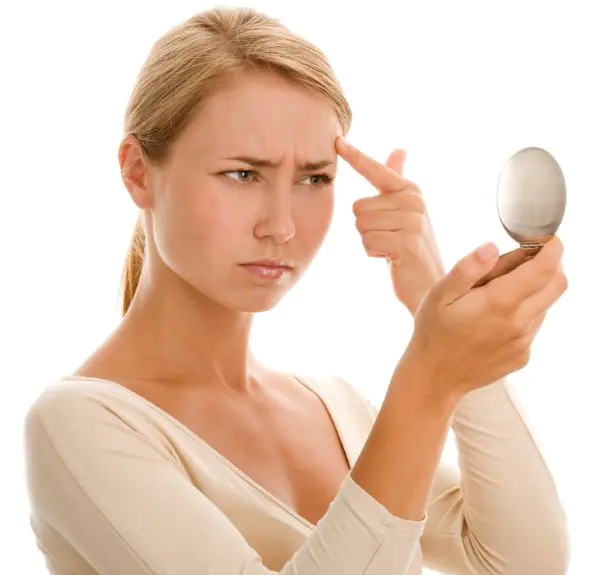
Every representative of the fairer sex imagines what kind of problem this is - acne on the face.
They manifest themselves as a skin disease that is associated with inflamed, red bumps.
There are many reasons for the occurrence of acne on the face of women, so they often turn to a doctor, whose main task is to find out why and how this skin disease appeared.
There are such types of acne:
- Comedo.
- Papule.
- Pustule.
- Nodular cystic acne.
- Lightning acne.
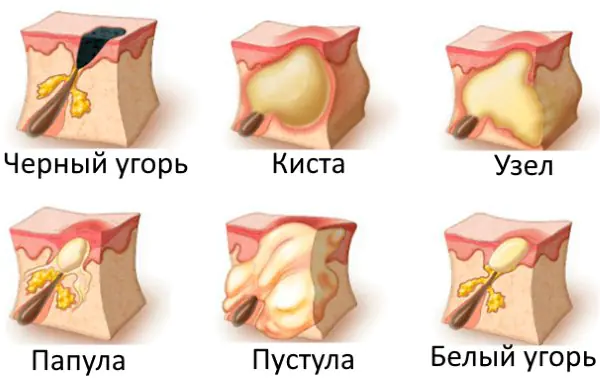
There are several types of acne.
A comedon, or sebaceous plug, appears when fat clogs a pore, forming a dark dot on its surface.
Sometimes such blockages are closed, when there are no blackheads, and excess fat expands the pore with a ball. They appear on the skin in the form of a hemisphere with a white tip.
Papule - the same comedon, but already inflamed, reddened, noticeably protruding. They are a sign of acne. It is advisable to take timely measures to prevent their formation.
Nodular cystic acne penetrates deep into the skin, they are painful, and very often unite, forming lesions, of which there are always many.
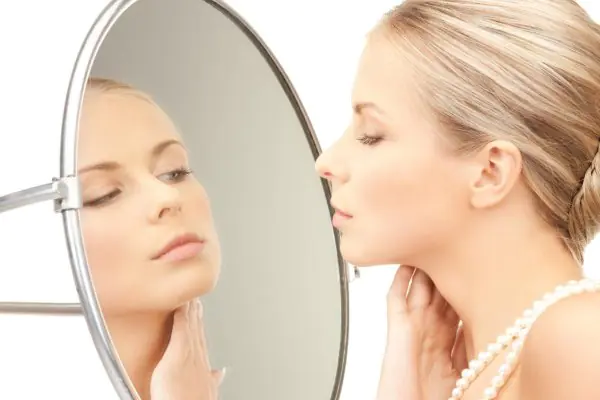
When pimples break out naturally, the skin tightens without leaving a mark.
Such pimples are bluish-red, and their tops, when filled with purulent discharge, become yellowish-gray. When they break through naturally, the skin tightens without leaving a mark.
And here fulminant acne needs medical treatment. They form nodes deep under the skin with a diameter of up to 5 mm, are quite painful, and can affect the blood count.
The most annoying consequence of these pimples is that they leave scars for a long time. It is too late to fight this skin disease on your own.
Causes of acne
It's no secret that women try by any means (in most cases - cosmetics) to hide the acne that appears on their face.
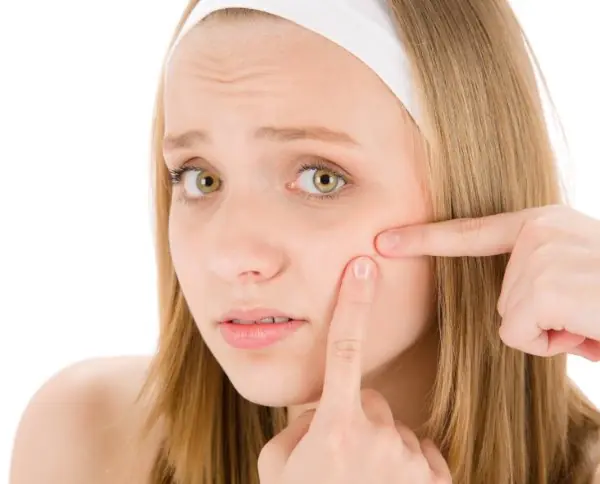
Acne often affects teenagers during puberty, that is, the period of puberty.
The causes of occurrence in women depend on the internal state of the body and skin, as well as third-party factors, but not on age. It has long been noted that acne can be said to “grow up.”
What is acne? This is an inflammation of the sebaceous gland and hair follicle. They often affect adolescents during puberty, that is, the period of puberty.
Adults are also affected by this problem, and their skin is affected more deeply and is more difficult to treat.
The main factor causing acne is:
- oily skin;
- “clogging” with dead cells;
- inflammatory process;
- dirt and bacteria.

The appearance of acne is also affected by your skin type.
The appearance of acne is also affected by your skin type:
- Dry. It is prone to dryness, thin with unnoticeable pores and is very rarely affected by acne.
- Normal. Looks hydrated and healthy. Acne rashes are minor on the forehead, less often on the chin.
- Combined. The skin often becomes shiny due to excess oil in the T-zone, where acne appears.
- Fat. It has a high secretion of sebaceous glands, the pores are noticeable and enlarged. This type of skin is very susceptible to acne. In severe cases, deep scars and dots remain on the skin, quite noticeable and unsightly.
Acne in teenagers
Juvenile acne appears at the onset of puberty at age 14, and usually goes away by the age of 20. Their appearance is oily skin, which directly depends on the hormonal state of the body.
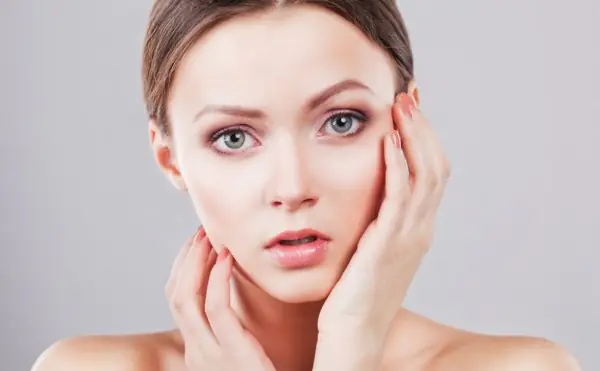
Juvenile acne appears at the onset of puberty at age 14 and usually goes away by age 20. Their appearance is due to oily skin.
The hormone testosterone is always present in the body of men and women; in adolescents, its level increases during puberty. Under his influence glands produce more fat, especially in the nose and forehead area. That's why almost all pimples are localized there.
Normal skin sheds old dead cells from time to time, but when excess sebum is present, these cells cannot separate on their own, they become oily, stick together, and clog pores. Subsequently, these places become inflamed and acne appears.
The appearance of acne in adult women
For women over the age of 30, acne on the face is a particularly unpleasant problem.
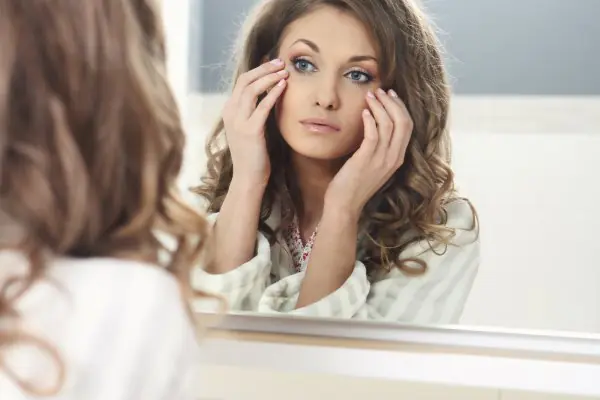
For women over the age of 30, acne on the face is a particularly unpleasant problem.
The causes of occurrence in women during non-adolescence can be caused by such factors:
- Stress.
- Hormonal imbalance.
- Menstrual irregularities.
- Climax.
- Pregnancy.
- Allergies.
- Features of the diet.
- Mechanical impact.
- Bad habits.
Many women develop acne up to the age of 40, even if they didn’t have it in their youth, often this happens before menstruation.

A very important factor is the overall hormonal level of the blood. It is affected by pregnancy.
A very important factor is the overall hormonal level of the blood. It is affected by pregnancy, contraceptives, various diseases, menopause, as well as irregular menstrual cycles.
As we already know, the main cause of acne on the face in women is the hormone testosterone. When there is an excess of it, the sebaceous glands produce too much oil, which clogs the pores.
The general condition of the body is negatively affected by sudden and prolonged stress.
They have a bad effect on the pituitary and adrenal glands, changing the balance of hormones in the body and leading to the appearance of acne in the chin area. In addition, many women begin to scratch them, and this causes exacerbations.
The cause of acne on the face of absolutely all women can be: allergies, scratches, abrasions and other damage to the skin, into which infection causes inflammatory processes.
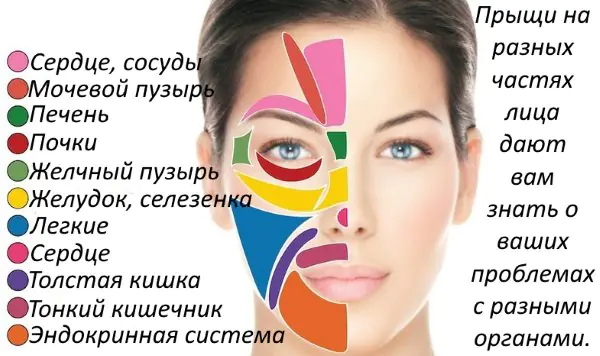
Acne in women is usually located on the chin, cheeks and neck - each zone is responsible for an internal organ.
This leads to acne in adults. Acne in women is usually located on the chin, cheeks and neck. While for boys and girls everything will go away over time, for adults it will not.
Inflammatory processes in their skin occur deeply and painfully. Acne leaves deep, unsightly marks on the skin.
Another cause of acne on the face can be diseases of the gastrointestinal tract: gastritis, ulcers, dysbacteriosis, tonsillitis and others, including chronic ones, in women of different ages.
The immune and lymphatic systems are greatly affected by poor nutrition and bad habits, leading to slagging of the body, and this provokes the appearance of acne.

Eat foods rich in zinc and vitamins, quit bad habits.
Eat foods rich in zinc and vitamins, quit bad habits.
Excessive cleanliness can also cause acne on the face. Frequent use of alcohol-based lotions dries out the skin and washes away its protective barrier.
Incorrectly selected cosmetics, for example, oil-based creams, additionally clog pores in women of different ages.
How to deal with acne on your face
With the first and second degree of acne damage, you can fight them yourself:
- fatty, sweet and carbohydrate foods should be excluded from the diet;
- wash your hands and face more often;
- use antiseptic creams that will protect the skin from bacteria and dust.
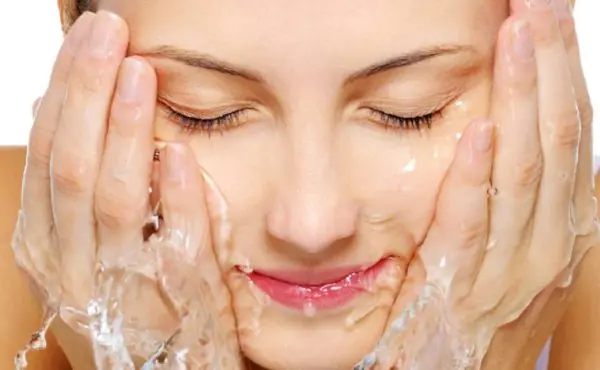
Wash your face and hands often.
Carefully! Oily skin needs hydration. Don't overdry it. Protect with a light moisturizer, do not get carried away with constant disinfection, take care of its protective function.
Treatment
In order to directly begin to eliminate unfortunate acne on your face, you can try traditional medicines and folk remedies on yourself.
So, among medications popular in use:
- Metrogyl-gel, ichthyol ointment and others.
- To stabilize metabolism, adsorbents are used: lactofiltrum, brewer's yeast.
- Antibacterial drugs are used for disinfection: levomekol, zinerite.
- Hormonal drugs reduce the activity of the sebaceous glands: hydrocortisone ointment.

In order to directly begin to eliminate unfortunate acne on your face, you can try traditional medications on yourself.
When can you squeeze out a pimple, and how? It is not advisable to do this yourself, you can get an infection.
But, if the pimple is mature enough, the inflammation goes away, and the pus has reached the top and appears as a light tubercle under thin skin, only now can it be helped.
How to do it:
- You need to wash your hands and face and wipe them with alcohol.
- Prepare an ironed thin cotton towel.
- Using a cloth, gently press on the base of the pimple, the pus will come out easily, but make sure this happens all the way. There will be no blood, only ichor will come out.
- You need to wipe this area with alcohol and let it dry.
- Apply antibiotic gel.
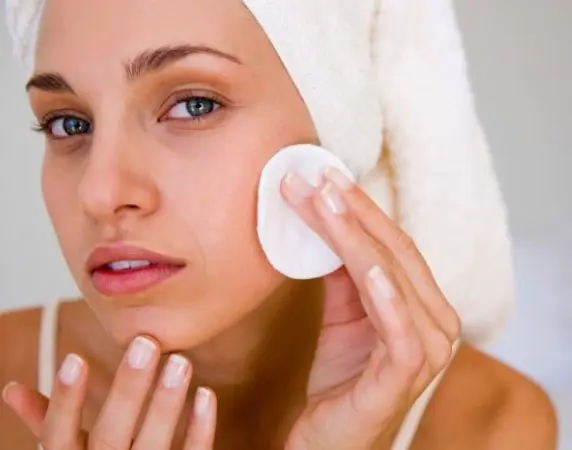
Wipe the affected area with alcohol.
If everything is done correctly, within a day there will be no trace left. For very oily skin, the same method can remove blackheads from acne.
Prevention of the disease is of great importance - cleanliness and skin care, a balanced diet and the right cosmetic solution.
The base of the cream should not be oils, as well as lanolin, red dyes, sodium lauryl sulfate, isotropyl myristate, laureth-4.
Herbal decoctions are used in folk medicine: flowers of chamomile, calendula, St. John's wort, sage leaf, nettle, yarrow and others.
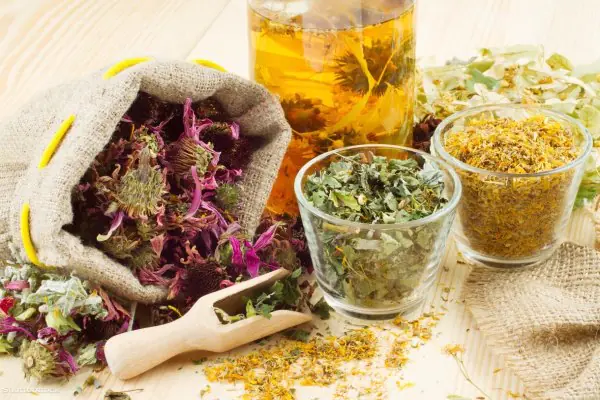
In folk medicine, decoctions of herbs are used: chamomile flowers, calendula, St. John's wort, sage leaves, nettles, yarrow and others.
Take 1 tbsp. l. raw materials (or collection), pour a glass of boiling water. Leave for 15 minutes, use for washing and as tea.
Once a month, before cleansing your face, take a 15-minute steam bath.
A mask made from egg yolk with lemon juice is useful. Use kefir, and in the summer - fresh cucumbers, apples, berries.

It is important to remember that the skin needs cleanliness, hydration and nutrition.
It is important to remember that skin needs cleanliness, hydration and nutrition. Learn to make healthy creams with your own hands that store well in the refrigerator.
Drink more water and moisturize your skin, keep it clean, as well as the health of your entire body.
This video will tell you the difference between treating acne in teenage and adult women.
This video will introduce you to ways to treat acne on the face in women.
This video will tell you the reasons for the appearance of acne in women after 30 years of age.



